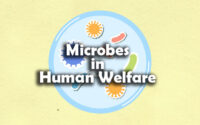Digestion and Absorption Questions and Answers
1. The optimum pH of pepsin is-—
A. 11
B. 5-6
C. 1.6-2.4
D. 4-7
2. Enzymes not present in pancreatic juice is-
A. Amylase
B. Chymotrypsinogen
C. Lipase
D. enterokinase
3. Vermiform appendix arises from-
A. caecum
B. colon
C. rectum
D. ileum
4. Choose the correct statement among the following.
A. The intestinal mucosal epithelium has oxyntic cells.
B. Ptyalin converts proteins into proteoses and peptones.
C. Crypts of Lieberkuhn is seen between the bases of villi in the intestine.
D. Sphincter of Oddi is present at the junction of oesophagus and cardiac stomach.
5. The secretions of the brush border cells of the intestinal mucosa along with the secretion of goblet cells constitute the—
A. succus entericus
B. chyme
C. gastric juice
D. chylomicrons
6. Identify the correctly matched structure and its secretion.
A. Brunner’s gland—Salivary amylase
B. intestinal mucosa—Insulin
C. Gallbladder -Bile
D. Salivary gland—Lysozyme
7. Emulsification of fat takes place through—
A. bile pigments
B. liver enzymes
C. bile salts
D. intestinal enzymes
8. In liver, ____ is converted into __________
A. urea, ammonia
B. ammonia, urea
C. nitrate, ammonia
D. ammonia, nitrate
9. Brunner’s glands are found in—
A. duodenum
B. Jejunum
C. stomach
D. both (a) and (b)
10. A patient with bleeding gums is advised to take fresh fruits and vegetables in diet specially because he suffers from —
A. Scurvy
B. night blindness
C. beri-beri
D. anaemia
11. Emulsificaiton of fat occurs by —
A. bile salts
B. bile pigments
C. pancreatic juice
D. succus entericus
12. Which one of the following vitamins is anti-haemorrhagic?
A. Vitamin B12
B. Vitamin B5
C. Vitamin C
D. Vitamin K
13. The initial step in the digestion of milk in human is carried out by–
A. Lipase
B. Trypsin
C. Rennin
D. pepsin
14. Fructose is absorbed into the blood through mucosa cells of intestine by the process called –
A. active transport
B. facilitated transport
C. simple diffusion
D. co-transport mechanism.
15. Choose the wrong statement among the following—
A. Trypsinogen is activated by enterokinase.
B. The optimum pH for salivary amylase activity is 8-9.
C. Rennin helps in the digestion of milk proteins
D. Goblet cells secrete mucous.
E. Submucosal glands of the intestine are also known as Brunner’s gland
16. Which of these is secreted by duodenum?
A. Somatostatin
B. Secretin
C. Gastrin
D. GIP
17. Enteropeptidase present in ‘Succus entericus’ converts ____.
A. alkaline medium to acidic medium
B. trypsinogen to trypsin
C. proteins to polypeptides
D. tyrosinase to tyrosine
18. The middle part of the small intestine is—
A. duodenum
B. jejunum
C. ileum
D. pyloric region.
19. A healthy person eats the following diet-5 gm raw sugar, 4 gm albumin, 10 gm pure buffalo ghee adult rated with 2 gm vegetable ghee (hydrogenated vegetable oil) and 5 gm lignin. How many calories he is likely to get?
A. 126
B. 164
C. 112
D. 144
20. Which of the following elements is a constituent of biotin?
A. Magnesium
B. Calcium
C. Phosphorus
D. Sulphur
21. lleocaecal valve is present in between—
A. colon and large intestine
B. colon and small intestine
C. stomach and small intestine
D. cardiac stomach and fundus.
22. In a normal adult, ascending order of concentration of following molecules is—
A. K<Na>Fe>Cu
B. Na>K>Cu>Fe
C. Fe>Na>K>Cu
D. Na>Fe>K>Cu.
23. Curdling of milk in small intestine would occur with the help of——
A. Renin
B. Erypsin
C. Trypsin
D. Chymotrypsin
24. Some symbiotic microorganism occur in human body in—
A. vermiform appendix and rectum
B. caecum
C. duodenum
D. oral lining and tongue surface
25. For activity of carboxypeptidase requires…
A. Zinc
B. Niacin
C. Copper
D. iron
26. Substrate for lipase is—
A. Fat
B. Protein
C. Carbohydrate
D. Nucleic acid
27. Cyanocobalamine is required for the maturation of—
A. RBC
B. Platelets
C. WBC
D. lymph
28. Which of the following acid is also a vitamin?
A. Ascorbic acid
B. Formic acid
C. Malic acid
D. Palmitic acid
29. During absorption of carbohydrates in the blood the most rapidly transported monosaccharide is—
A. Glucose
B. Galactose
C. Fructose
D. sucrose
30. Which one of the following vitamins is manufactured in human liver?
A. Vitamin A
B. Vitamin D
C. Vitamin C
D. Vitamin K
31. The layer lining the lumen of the human alimentary canal is—
A. Serosa
B. sub-mucosa
C. muscularis
D. mucosa
32. Common passage for bile and pancreatic juice is—
A. Duct of Wirsung
B. Duct of Satorini
C. Ductus choleductus
D. Ampulla of vater
33. Faleiform ligament connects—
A. Stomach and liver
B. Stomach and diaphragm
C. Liver with diaphragm
D. Lungs with diaphragm
34. Argentaffin cells in human beings are found in—
A. small intestine
B. stomach
C. large intestine
D. liver
35. In human beings, the three pair of salivary glands and numerous buccal glands produce about–
A. 1.0 dm3 of saliva per day
B. 1.5 dm3 of saliva per day
C. 2.0 dm3 of saliva per day
D. 2.5 dm3 of saliva per day
36. ln the gastrointestinal tract the Meissner’s plexus the Auerbach’s plexus occurs respectively in the –
A. lamina propria and muscularis mucosa
B. submucosa and muscularies externa
C. submucosa and mucosa
D. mucosa and muscularis externa.
37. Saliva produced per day is—
A. 1.0 dm3
B. 1.5 dm3
C. 2.0 dm3
D. 2.5 dm3
38. Peristalsis occurs in
A. Urethra
B. Ureter
C. Blood vessels
D. Alimentry canal
39. One of the constituents of pancreaticjuice which is poured into duodenum is
A. Trypsinogen
B. Chymotrypsin
C. Trypsin
D. enterokinase
40. Which one is a gastrointestinal hormone—
A. Prolactin
B. GH
C. Enterokinase
D. FSH
41. Backflow of foecal matter from large intestine is prevented by—
A. Epiglottis
B. Sphincter of Oddi
C. lleocaecal valve
D. Pyloric sphincter
42. Good vision depends on adequate intake of carotene rich food.
Select the best option from the following statements.
A. Vitamin A derivatives are formed from carotene.
B. The photopigments are embedded in the membrane discs of the inner segment.
C. Retinal is a derivative of Vitamin A.
D. Retinal is alight absorbing part of all the visual photopigments.
A. (A) and (B)
B. (A), (C) and (D)
C. (A) and (C)
D. (B), (C) and (D)
43. A baby boy aged two years is admitted to play school and passes through a dental check-up. The dentist observed that the boy had twenty teeth. Which teeth were absent?
A. Incisors
B. Canines
C. Pre-molars
D. Molars
44. Which of the following options best represents the enzyme composition of pancreatic juice?
A. amylase, peptidase, trypsinogen, renin
B. amylase, pepsin, trypsinogen, maltase
C. peptidase, amylase, pepsin, renin
D. lipase, amylase, trypsinogen, procarboxy peptidase
45. Which hormones do stimulate the production of pancreatic juice and bicarbonate?
A. Angiotensin and epinephrine
B. Gastrin and insulin
C. Cholecystokinin and secretin
D. Insulin and glucagon
46. Which of the following guards the opening of hepatopancreatic duct into the duodenum?
A. Pyloric sphincter
B. Sphincter of Oddi
C. Semilunar Valve
D. Ileocaecal Valve
47. In the stomach, gastric acid is secreted by the—
A. peptic cells
B. acidic cells
C. gastrin secreting cells
D. parietal cells
48. Which one of the following is the correct matching of a vitamin, its nature and its deficiency disease?
A. Vitamin A—-Fat soluble——Night blindness
B. Vitamin K—Fat s0luble——Beri beri
C. Vitamin A—-Fat soluble——Beri beri
D. Vitamin K—water soluble—Pellagra
49. The main function of the lacteal in the villi of human small intestine is to absorb—
A. fat globules
B. water and mineral salts
C. amino acids
D. glucose and amino acids
50. Digestions of proteins is incomplete in the absence of enterokinase, because-
A. trypsinogen is not converted into trypsin.
B. pepsinogen is not converted into pepsin.
C. Prorennin is not converted into renin
D. chymotrypsinogen is not converted into chymotrypsin.
51. Which one of the following pairs is not correctly matched?
A. Vitamin B12—Pernicious anaemia
B. Vitamin B6—Loss of appetite
C. Vitamin B1 —Beri beri
D. Vita min B2—Pellagra
52. The primary dentition in human differs from permanent dentition in not having one of the following type of teeth.
A. Molars
B. Incisors
C. Canines
D. Premolars
53. The enzyme that is not present in succus entericus is—
A. Nucleosidase
B. Lipase
C. Maltase
D. nuclease
54. The epithelium found in the inner linings of stomach and intestine is—
A. Columnar
B. Squamous
C. Stratified
D. pseudo-stratified
55. The hormone that stimulates the release of pancreatic juice is—
A. Secretin
B. Glucagon
C. Inhibin
D. insulin
56. Zymogenic cells of gastric gland secrete—
A. Pepsinogen
B. Trypsin
C. Pepsin
D. chymotrypsin
57. The usual cause (s) of peptic ulceration is/are—
(i) lower rate of secretion of gastric juice
(ii) higher rate of secretion of gastric and duodenal
(iii) improper neutralisation of gastric juice by duodenal juices
(iv) imbalance between the rate of secretion of gastric juice and the degree of protection offered by gastroduodenal mucosa.
A. i & iv
B. ii & iii
C. i & ii
D. iii & iv
58. Which one of the following vitamins is not fat soluble?
A. A
B. B
C. D
D. E
59. The deficiency of which of the following vitamins will cause exrophthalmia?
A. A
B. B
C. C
D. K



